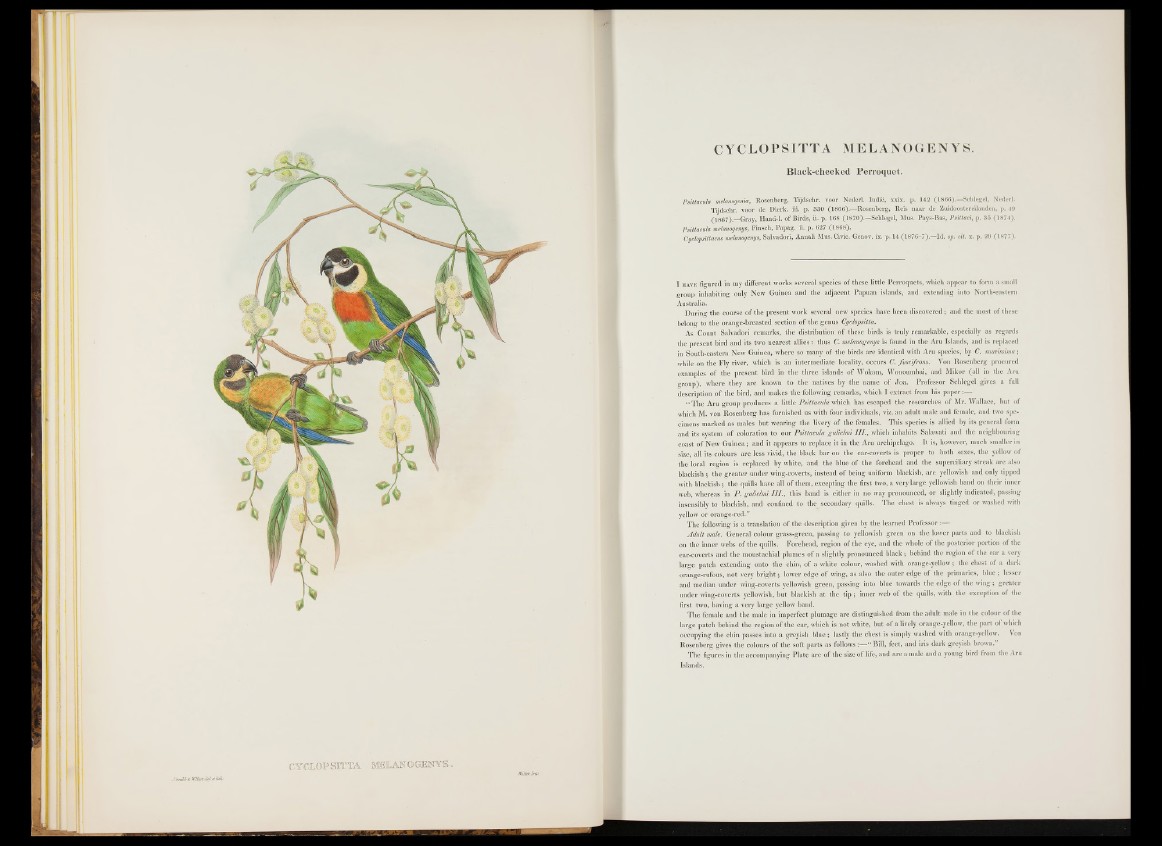
Black-cheeked Perroquet.
Psittacula melanogenia, Rosenberg, Tijdschr. voor Nederl. Indie, xxix. p. 142 (1866).—Schlegel, Nederl.
Tijdschr. voor de Dierk. iii. p. 330 (1866).—Rosenberg, Reis naar de Zuidoostereilanden, p. 49
( 1867).—Gray, Hand-1, of Birds, ii. p. 168 (1870).—Schlegel, Mus. Pays-Bas, Psittaci, p. 35 (1874).
Psittacula melanogenys, Finsch, Papag. ii. p. 627 (1868).
Cyclopsittacus melanogenys, Salvadori, Annali Mus. Civic. Genov, ix. p. 14 (1876-7).—Id. op. cit. x. p. 29 (1877).
I h a v e figured in my different works several species o f these little Perroquets, which appear to form a small
group inhabiting only New Guinea and the adjacent Papuan islands, and extending into North-eastern
Australia.
During the course o f the present work several new species have been discovered; and the most o f these
belong to the orange-breasted section o f the genus Cyclopsitta.
As Count Salvadori remarks, the distribution o f these birds is truly remarkable, especially as regards
the present bird and its two nearest a llies: thus C. melanogenys is found in the Aru Islands, and is replaced
in South-eastern New Guinea, where so many o f the birds are identical with Aru species, by C. suavissima;
while on the Fly river, which is an intermediate locality, occurs C. fuscifrons. Von Rosenberg procured
examples of the present bird in the three islands of Wokam, Wonoumbai, and Mikor (all in the Aru
group), where they are known to the natives by the name o f Jo a . Professor Schlegel gives a full
description o f the bird, and makes the following remarks, which I extract from his p a p e r:—
“ T h e Aru group produces a little Psittacula which has escaped the researches of Mr. Wallace, but of
which M. von Rosenberg has furnished us with four individuals, viz. an adult male and female, and two specimens
marked as males but wearing the livery of the females. This species is allied by its general form
and its system o f coloration to our Psittacula gulielmi I I I ., which inhabits Salawati and the neighbouring
coast o f New Gu in ea; and it appears to replace it in the Aru archipelago. I t is, however, much smaller in
size, all its colours are less vivid, the black bar on the ear-coverts is proper to both sexes, the yellow of
the loral region is replaced by white, and the blue o f the forehead and the superciliary streak are also
blackish ; the g reater under wing-coverts, instead o f being uniform blackish, a re yellowish and only tipped
with blackish ; the quills have all of them, excepting the first two, a very large yellowish band on their inner
web, whereas in P . gulielmi I I I ., this band is either in no way pronounced, or slightly indicated, passing
insensibly to blackish, and confined to the secondary quills. The chest is always tinged or washed with
yellow or orange-red.”
T he following is a translation o f the description given by the learned Professor :—
A du lt male. General colour grass-green, passing to yellowish green on the lower parts and to blackish
on the inner webs o f the quills. Forehead, region o f the eye, and the whole o f the posterior portion o f the
ear-coverts and the moustachial plumes o f a slightly pronounced b lack ; behind the region of the ear a very
large patch extending onto the chin, o f a white colour, washed with orange-yellow; the chest of a dark
orange-rufous, not very b r ig h t; lower edge o f wing, as also the outer edge o f the primaries, blue ; lesser
and median under wing-coverts yellowish green, passing into blue towards the edge o f the w in g ; greater
under wing-coverts yellowish, but blackish a t the t i p ; inner web of the quills, with the exception of the
first two, having a very large yellow band.
T h e female and the male in imperfect plumage are distinguished from the adult male in the colour of the
large patch behind the region o f the ear, which is not white, but o f a lively orange-yellow, the part of which
occupying the chin passes into a greyish b lu e ; lastly the chest is simply washed with orange-yellow. Von
Rosenberg gives the colours o f the soft parts as follows:— “ Bill, feet, and iris dark greyish brown.”
The figures in the accompanying Plate are o f the size o f life, and are a male and a young bird from the Aru
Islands.